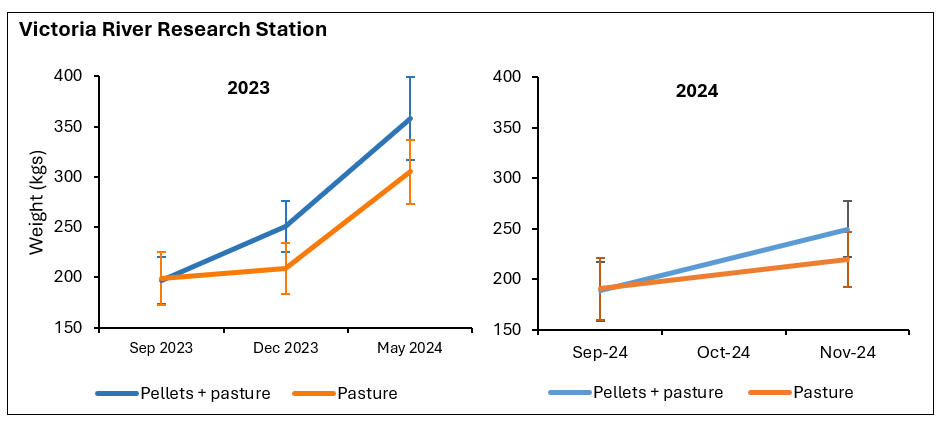Crops for cattle
Increasing the efficiency of north Australian cattle production systems using local crops to improve dry season weight gain
Supported by the Cooperative Research Centre for Developing Northern Australia (CRCNA), the Northern Territory Department of Agriculture and Fisheries (DAF) has recently begun field work for the Crops for Cattle project. The project is being conducted on eight commercial properties across the Northern Territory as well as two DAF research stations.
Aim
The project aims to foster the integration of northern cropping and cattle production systems with the majority of the feed being sourced through local cropping and feed mills. The increase in dry season weight gain that can be achieved from various locally grown crops and feeds will be documented, and economic analyses will be conducted to determine the feed cost/cattle price combinations at which the feeding strategies are profitable. This will help to foster local markets for northern crops and increase the rate of cattle production.
Increased live weight gain in the post-weaning dry season would allow a higher proportion of steers to be turned off after just one wet season. Alternatively, steers that don’t quite make the export weight after a wet season could be fed for a short period instead of having to hold them over for another year. Another positive flow-on effect is increased whole-herd productivity; as higher heifer weights at joining result in higher pregnancy rates and an earlier and more uniform calving window.
The three main components of the project are:
- Feeding trials: documenting dry season liveweight gain from the supplementary feed or crop of the property’s choice. Good data is essential for the following components.
- Economic modelling: Examining the whole-of-herd impacts of increased dry season growth on the structure, productivity and profitability of cattle herds in northern Australia. This will enable an assessment of the effects of variation in the sale price of cattle ($/kg) and supplement cost ($/t) on the profitability of the feeding strategies. One of the outputs will be grids showing the feed prices at which dry season feeding becomes profitable at different cattle prices, for feeds that give different amounts of dry season liveweight gain. This will ensure that the findings of the project remain relevant when cattle and feed prices fluctuate.
- Investigating the potential for carbon credits: More productive and efficient females means fewer breeders are needed for the same output; and increased liveweight gain allows steers to be turned off earlier. Both of these factors will reduce whole-of-life methane emissions. This prospect will be explored to see whether it could be an approved method for obtaining carbon credits.
Progress update
Data collection was completed for nine properties across the NT’s top end in 2023 and 2024. A variety of feeding strategies and feed types were undertaken. These included providing pelleted feed in addition to pasture, feeding animals on cultivated crops (such as forage sorghum) or improved pastures and keeping weaners in a feedlot setup where they were fed a ration before being either turned out to a paddock or sold.
Trial design: Pelleted feed + pasture vs only pasture
Two of the properties that trialled a pelleted feed in addition to native pasture were the Katherine Research Station (KRS) and Victoria River Research Station (VRRS). Both properties fed one paddock of weaners for approximately 90 days starting in September, with another paddock of weaners grazed on pasture only as a comparison.
This feeding strategy was designed so that as the weaners came to the end of their 90 days with pelleted feed, the first rains should have occurred and green feed would be available in the paddock so they will continue gaining weight rather than losing the benefit of the feeding if there is an extended period of poor nutrition before green pasture is available.
Weight change
At both properties, in both 2023 and 2024, weaners fed pellets in addition to the available pasture had better weight gains than weaners fed on pasture alone: At VRRS in 2023 the weaners fed pellets gained 44 kg more over the feeding period and this growth advantage was maintained over the following wet season (see Graph 1 and 2 below). In 2024 the group fed pellets gained 32 kg more than the control group over the feeding period. At KRS the group fed pellets gained 27 kg more weight in 2023 and 50 kg more weight in 2024.

Economic analysis
Basic economic analyses have been performed on the 2023 feeding programs, comparing cost of feed vs extra kilograms gained at the current feed cost and cattle prices. The feeding program was found to be profitable at Victoria River Research station, while not profitable at Katherine Research Station. The results for 2024 are still being calculated.
Publications
One page submission to the Joint AAAP & AAAS Animal Production Congress 2024: Crops for cattle — increasing the efficiency of north Australian cattle production systems through using local crops to improve dry season weight gain (PDF, 500 KB).
Project leader
Tim Schatz, Director Livestock Industries, NT Department of Agriculture and Fisheries
P: 08 8999 2332
M: 0429 677 833
